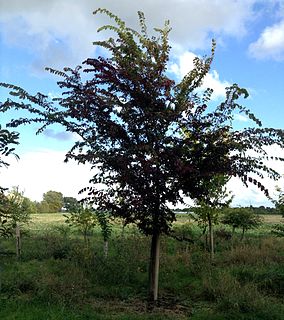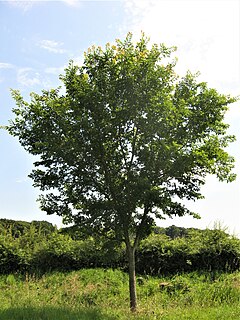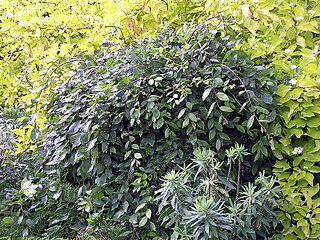| Ulmus parvifolia 'Drake' | |
|---|---|
 Autumnal foliage, U. parvifolia 'Drake' | |
| Species | Ulmus parvifolia |
| Cultivar | 'Drake' |
| Origin | US |
The Chinese Elm cultivar Ulmus parvifolia 'Drake' was marketed by the Monrovia Nursery of Azusa, California from 1952 to 1953.
| Ulmus parvifolia 'Drake' | |
|---|---|
 Autumnal foliage, U. parvifolia 'Drake' | |
| Species | Ulmus parvifolia |
| Cultivar | 'Drake' |
| Origin | US |
The Chinese Elm cultivar Ulmus parvifolia 'Drake' was marketed by the Monrovia Nursery of Azusa, California from 1952 to 1953.
The tree has upright, spreading branches bearing dark-green leaves. [1] 'Drake' is also distinguished by having a bark that begins exfoliating at a relatively young age .
The species and its cultivars are highly resistant, but not immune, to Dutch elm disease, and unaffected by the Elm Leaf Beetle Xanthogaleruca luteola . [2]
'Drake' became the most popular form of U. parvifolia planted in the southern and western states of the United States. [3] One specimen is known to have been introduced to Europe.
(Widely available)

Ulmus bergmannianaC.K.Schneid., commonly known as Bergmann's elm, is a deciduous tree found across much of China in forests at elevations of 1500–3000 m.

Ulmus laciniata(Trautv.) Mayr, known variously as the Manchurian, cut-leaf, or lobed elm, is a deciduous tree native to the humid ravine forests of Japan, Korea, northern China, eastern Siberia and Sakhalin, growing alongside Cerciphyllum japonicum, Aesculus turbinata, and Pterocarya rhoifolia, at elevations of 700–2200 m, though sometimes lower in more northern latitudes, notably in Hokkaido.

Ulmus 'Frontier' is an American hybrid cultivar, a United States National Arboretum introduction derived from a crossing of the European Field Elm Ulmus minor with the Chinese Elm Ulmus parvifolia in 1971. Released in 1990, the tree is a rare example of the hybridization of spring- and autumn-flowering elms. Tested in the US National Elm Trial coordinated by Colorado State University, 'Frontier' averaged a survival rate of 74% after 10 years.

Ulmus 'Homestead' is an American hybrid elm cultivar raised by Alden Townsend of the United States National Arboretum at the Nursery Crops Laboratory in Delaware, Ohio. The cultivar arose from a 1970 crossing of the Siberian Elm Ulmus pumila with the hybrid N 215, the latter grown from seed sent in 1960 to the University of Wisconsin-Madison elm breeding team by Hans Heybroek of the De Dorschkamp Research Institute in the Netherlands. Tested in the US National Elm Trial coordinated by Colorado State University, 'Homestead' averaged a survival rate of 85% after 10 years. 'Homestead' was released to commerce without patent restrictions in 1984.

Ulmus 'Morton Glossy' is a hybrid cultivar raised by the Morton Arboretum, Illinois. Originally named 'Charisma' until it was realized that name had already been registered for another plant, the tree was derived from a crossing of two other hybrid cultivars grown at the Morton: Accolade and Vanguard. Tested in the US National Elm Trial coordinated by Colorado State University, Triumph averaged a survival rate of 86% after 10 years. Triumph was introduced to the UK in 2006 by the Frank P. Matthews nursery in Worcestershire.
Ulmus 'Morton Plainsman' is a hybrid cultivar raised by the Morton Arboretum from a crossing of Siberian Elm and a Japanese Elm grown from openly pollinated seed donated by the Agriculture Canada Research Station at Morden, Manitoba. Tested in the US National Elm Trial coordinated by Colorado State University, Vanguard averaged a survival rate of 78% after 10 years.

Ulmus 'Morton Stalwart', is a Morton Arboretum hybrid cultivar arising from a controlled crossing of Accolade with the hybrid of a Field Elm U. minor from eastern Russia and a Siberian Elm U. pumila. Tested in the US National Elm Trial coordinated by Colorado State University, Commendation averaged a survival rate of 85% after 10 years.

The American Elm cultivar Ulmus americana 'Valley Forge' was raised by the Agricultural Research Service in Maryland. The tree was released to wholesale nurseries without patent restrictions by the U. S. National Arboretum in 1995 after proving to have a high resistance to Dutch elm disease. 'Valley Forge' proved only moderately successful in the US National Elm Trial, averaging a survival rate of 66.7% overall, owing largely to environmental factors rather than susceptibility to disease.

The American Elm cultivar Ulmus americana 'New Harmony' was raised by the Maryland Agricultural Research Service and released by the United States National Arboretum in 1995, along with 'Valley Forge'. 'New Harmony' proved the most successful U. americana cultivar in the US National Elm Trial, averaging a survival rate of 85.5% overall.
The Chinese Elm cultivar Ulmus parvifolia 'Burgundy' is a small American development.

Ulmus parvifolia 'Emer II' or 'Emerald Vase' is a Chinese Elm cultivar that was cloned from a tree planted circa 1910 on the University of Georgia campus at Athens.
The Chinese Elm cultivar Ulmus parvifolia 'Emer I' or 'Emerald Isle' was cloned from a tree planted circa 1920 on the University of Georgia campus at Athens.
Ulmus parvifolia 'A. Ross Central Park' is a Chinese elm cultivar that is probably the hardiest in cultivation and was patented in 1989 by David F. Karnosky. The original tree grew near the entrance to Central Park, at the junction of Fifth Avenue and 72nd Street in the Upper East Side of Manhattan in New York City, and died in the 1990s aged over 100 years. The cloning project was initiated in 1976 by the Arthur Ross Foundation, and executed by the School of Forestry and Wood Products, Michigan Technological University, Houghton.
The Chinese Elm cultivar Ulmus parvifolia 'Dynasty' is a United States National Arboretum introduction reputed to be very fast-growing.

The Chinese Elm cultivar Ulmus parvifolia 'Sempervirens' is an American introduction, commonly known by the synonym 'Evergreen', and may also be in synonymy for U. parvifolia 'Pendens'.
Ulmus davidianavar.japonica 'JFS-Bieberich' is a Japanese Elm cultivar that was raised by the Sunshine Nursery, Oklahoma, from seed collected in China by proprietor Steve Bieberich. Emerald Sunshine proved only moderately successful in the US National Elm Trial, averaging a survival rate of 70% overall.

The winged elm cultivar Ulmus alata 'Lace Parasol' was found by a North Carolina nurseryman growing in local woods. Removed to his yard, it remained there until his death, when it was removed again to the North Carolina State Arboretum in Raleigh by J. C. Raulston.
The Chinese Elm cultivar Ulmus parvifolia 'Pendens' was listed by Rehder in Journal of the Arnold Arboretum 26: 473, 1872 as Ulmus parvifolia f. pendens.
The Chinese Elm cultivar Ulmus parvifolia 'Yarralumla' is a cultivar raised by the Yarralumla Nursery in Canberra, Australia.

Ulmus parvifolia, commonly known as the Chinese elm or lacebark elm, is a species native to eastern Asia, including mainland China, Taiwan, Japan, North Korea, South Korea and Vietnam. It has been described as "one of the most splendid elms, having the poise of a graceful Nothofagus".